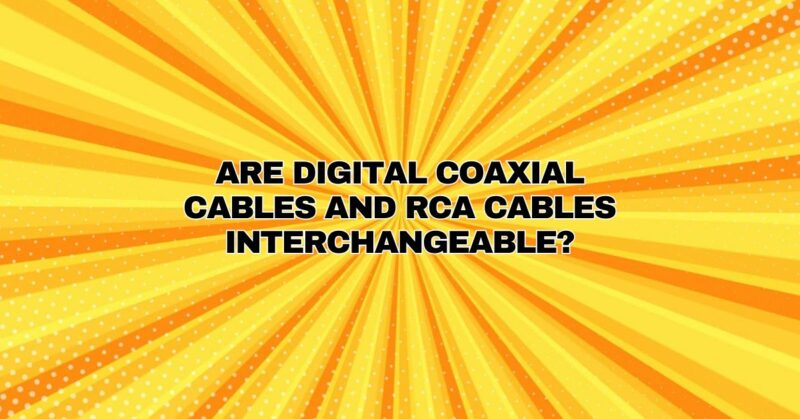In the world of audio and video connectivity, cables play a pivotal role in ensuring that signals are transmitted effectively between devices. Two commonly used cable types that often share similarities are digital coaxial cables and RCA (Radio Corporation of America) cables. Given their physical resemblance and the presence of RCA connectors on digital coaxial cables, questions arise about whether these two cable types are interchangeable. This comprehensive guide will explore the compatibility between digital coaxial cables and RCA cables and provide insights into when and how they can be used interchangeably.
Understanding Digital Coaxial Cables
Digital coaxial cables are designed for the transmission of digital audio signals. They are characterized by their construction, consisting of a central conductor, insulation, a metallic shield, and an outer insulating layer. Digital coaxial cables are known for their ability to transmit high-quality audio with minimal interference.
Key Features of Digital Coaxial Cables:
- Digital Signals: Digital coaxial cables are specifically engineered to transmit digital audio signals. These signals consist of discrete binary data, which ensures high-fidelity audio transmission.
- RCA Connectors: Digital coaxial cables often feature RCA connectors, similar to those found on analog RCA cables. However, it’s important to note that the signal they carry is entirely different.
- Applications: Digital coaxial cables are commonly used for connecting digital audio sources, such as DVD players, Blu-ray players, gaming consoles, and cable/satellite boxes, to digital audio equipment, including A/V receivers, soundbars, and home theater systems.
Understanding RCA Cables
RCA cables, also known as phono cables, are a versatile type of cable that can transmit both analog audio and video signals. They are distinguished by their color-coded connectors, with red typically representing the right audio channel, white for the left audio channel, and yellow for video.
Key Features of RCA Cables:
- Analog and Video Signals: RCA cables are capable of transmitting both analog audio and video signals. They carry analog signals, which are characterized by variations in voltage, making them suitable for audio and video connections.
- Color-Coding: RCA cables use color-coded connectors to distinguish between audio channels and video. This makes it easy to identify and connect the appropriate channels.
- Applications: RCA cables have a wide range of applications, including connecting older audio and video equipment, such as VCRs, DVD players, stereo systems, and gaming consoles.
Interchangeability: When Can You Swap Them?
While digital coaxial cables and RCA cables may share similar connectors, their signal types and intended purposes are distinct. As a result, they are not directly interchangeable in all situations. However, there are specific scenarios where limited interchangeability is possible:
- Digital Coaxial Output to RCA Input: You can use a digital coaxial cable with RCA connectors on the source end (digital coaxial output) to connect to an RCA input on the receiving device (e.g., a soundbar or home theater system). In this case, the digital audio signal from the source is converted to analog audio by the receiving device, allowing you to use the digital coaxial cable as an alternative to a dedicated RCA cable.
- Digital Coaxial Output on Source: Some source devices, like DVD players or Blu-ray players, may have both digital coaxial and analog RCA outputs. If your audio setup lacks digital coaxial inputs but has RCA inputs, you can use a digital coaxial cable connected to the source’s digital coaxial output and then use a digital-to-analog converter (DAC) to convert the signal to analog audio. From there, you can connect the DAC to the RCA inputs of your audio system.
Considerations and Limitations:
- Signal Conversion: When using a digital coaxial cable with an RCA connector on one end, remember that the digital signal needs to be converted to analog if your receiving device only accepts analog input.
- Loss of Digital Benefits: If you use a digital coaxial cable with an RCA input, you may lose the benefits of digital audio, such as surround sound formats like Dolby Digital or DTS, which can only be preserved through a digital connection.
- Quality and Compatibility: The quality of the signal and the compatibility of the devices involved in the connection can affect the overall audio experience. Be sure to use high-quality cables and converters to minimize signal loss and interference.
Conclusion
Digital coaxial cables and RCA cables, while sharing RCA connectors on occasion, serve different purposes and transmit distinct types of signals. While there are limited scenarios where you can use them interchangeably, it’s essential to understand the specific requirements and limitations of your audio setup. Proper signal conversion and quality maintenance are key factors in ensuring a successful interchangeability between these two cable types. Whether you choose to use digital coaxial or RCA cables, understanding their unique characteristics will help you make informed decisions when connecting your audio and video equipment.


